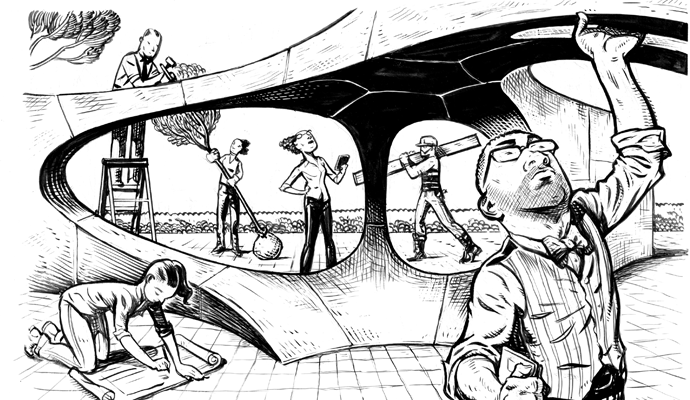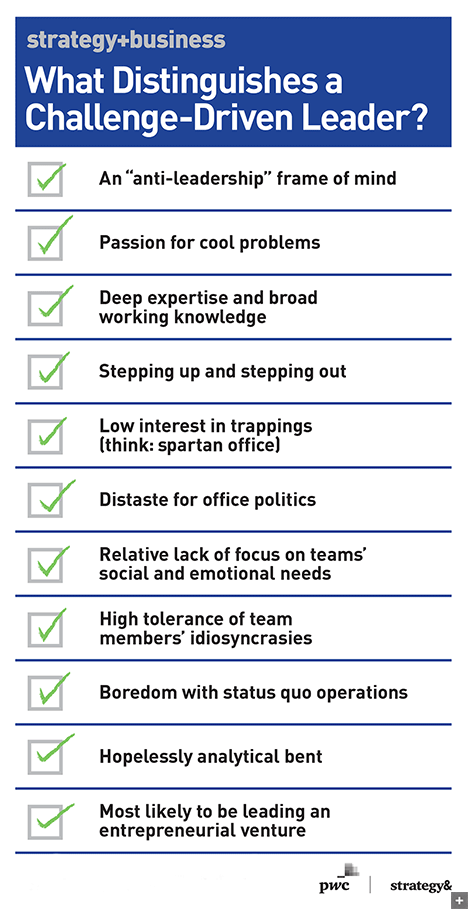How to cultivate leadership that is honed to solve problems
Achieve breakthroughs by bringing together experts who love challenges.
A version of this article appeared in the Spring 2018 issue of strategy+business.
In the aftermath of the Boston Marathon bombing in 2013, the terrorists responsible for that act took the life of a police officer, Sean Collier, who worked at the Massachusetts Institute of Technology (MIT). Those who knew and loved him at MIT resolved to commemorate his memory. J. Meejin Yoon, head of MIT’s department of architecture, designed a memorial that would honor Collier’s love of the outdoors and spirit of service, while reflecting the university community he served. The memorial is composed of massive interlocking granite blocks. Making them stand up required a feat of engineering that pushed the technical limits of the material. A multidisciplinary group assembled to figure out how to complete the project. The group included faculty, students, and staff with expertise in architecture, construction, engineering, and masonry, as well as consulting experts in structural and civil engineering, landscape architecture, and lighting design. No one person directed the project from start to finish; instead, teams stepped up and stepped out, forming for just as long as their expertise was needed. The Collier Memorial was unveiled on April 29, 2015, just a few days after the second anniversary of the officer’s death. It stands today on MIT’s campus as a tribute to a life given in service to a community that rises to meet challenges.
When a collaborative project like the Collier Memorial comes to fruition, it might seem to happen without leaders. But in reality, the many leaders involved were following a model of leadership that is hard to spot until you know how to look for it. We call this approach challenge-driven leadership. These leaders are propelled by the intrinsic desire to solve problems and meet challenges creatively. They are not motivated by the trappings of authority, status, or showmanship. They don’t particularly want to lead, and they certainly don’t want to be led. But they excel at choreographing and directing the work of others, because their expert knowledge enables them to spot opportunities to innovate in a way that cannot be done by working alone.
Challenge-driven leaders don’t want to lead or be led. But they excel at choreographing the work of others.
Challenge-driven leadership is not right for every situation. But where innovation and entrepreneurship are required — and in particular where developing a solution requires drawing together diverse talents and perspectives to discover novel approaches — it tends to work well. No wonder we find it in many places where people are dealing with “wicked problems,” a term coined in 1967 by design theorist Horst Rittel that refers to broad challenges with no obvious solutions. This is the kind of leadership that many companies, government agencies, and nonprofits would do well to recognize and cultivate.
Anti-Leader Leadership
When we first encountered challenge-driven leadership, we were looking for something that might explain MIT’s unique impact. MIT-educated people create enormous economic value, on top of their constant contributions to basic science and technology development. According to the Kauffman Foundation, MIT alumni have launched more than 30,200 active companies that collectively employ roughly 4.6 million people and generate roughly US$1.9 trillion in annual revenues. If these alumni made up a single nation’s business community, it would land between the world’s ninth-largest GDP, Russia's ($2.1 trillion), and the 10th-largest, India's ($1.9 trillion). Beyond the impressive statistics, we see evidence on a daily basis of interesting, high-impact work conducted by teams at or connected with the school. Yet MIT isn’t often thought of as a breeding ground for leaders of large enterprises the way Harvard and GE are. Clearly, big things get accomplished there in a way people don’t recognize as traditional leadership.
We ultimately found that there is in fact a distinctive kind of leadership taking place at many levels of MIT, evident everywhere from student projects to faculty startups to alumni enterprises. It is based, in part, on the personal qualities that many MIT people share. Many arrive as introverts, relative outliers in their past environments, and find joy in becoming part of a community of people more like themselves — those who love science and technology, and who hold the same deep wish to solve the planet’s mysteries. But there’s more to challenge-driven leadership than just a scientific personality; it’s also evident in the arts, among many entrepreneurs, and in social ventures. MIT happens to be one place where the conditions are ripe for challenge-driven leadership to emerge, and is thus a good launching point for observations and hypotheses about it.
Studying leadership at MIT is a little like looking for dark matter in the cosmos. The evidence for it may exist, but it isn’t disposed to reveal itself. Many MIT people don’t even like the word leader, and don’t show any eagerness to apply it to themselves. Dava Newman, who is the Apollo Professor of Astronautics and Engineering Systems at the school and also the former deputy administrator of NASA, puts it this way: “They’re very comfortable in their skin” as technologists, mathematicians, and so forth, but giving them the label of leader “might be a little shocking to them.” Those jockeying for leadership roles are often seen at MIT as ambitious, self-promoting, political, and power hungry — not as committed to making progress toward goals.
If you are an executive seeking a similar level of challenge-driven leadership, how should you cultivate it? You have to create conditions under which it would flourish. Do this routinely, and you will develop your company’s capacity for ongoing, high-impact innovation. Below we spell out the factors that we believe, on the basis of our interviews and observations, can make the most difference.
A Problem-Solving Ethos
Recently, a group of leaders from another renowned university visited with MIT faculty, looking for insights on how to spark the boundary-spanning innovation that seems to happen so naturally in Cambridge. The visiting school’s dean asked, “What does it take to get that magic? How much money do we have to invest? Do we need to dedicate a space?” The MIT faculty shook their heads, but seemed unable to name the secret — until one said, “You have to start with really hard, edgy, cool problems.”
If people at MIT don’t want to be leaders, then what do they aspire to? Solving problems wins them prestige and brings them satisfaction. They recognize the value of being generally knowledgeable and well educated, but they pride themselves most on their deep expertise in particular areas. They don’t want to delegate their most creative, in-depth, specialized work, so they take on the burden of generalist leadership reluctantly, and cede it readily. Leadership becomes an intermittent activity. People with enthusiasm and expertise step up as needed, and readily step out when, considering the needs of the project, another team member’s strengths become more central. One student put it this way: “A lot of times when people…hold leadership positions here at MIT, it’s not that they necessarily want to, but…they feel like they have to. [They’re] personally motivated for an idea.”
Take the Hyperloop project, which formed after the firm SpaceX announced it would give a prize to the university team that could design a critical component of a new high-speed transportation system envisioned by Elon Musk. For the MIT team’s “pod” to win, it had to have adequate speed, braking, stability, and levitation. That demanded that students in aeronautics, mechanical engineering, electrical engineering, and computer science tackle the problem together. After the team won the competition, leader John Mayo described to a Boston Herald reporter why they had been motivated to work so hard together. “Hyperloop has the ability to have a good impact on the environment…and just advance physical transportation in general,” he said. “That’s why we go to school, [to] meet challenges and solve problems.”
MIT faculty member Rebecca Saxe, who conducts groundbreaking research on brain function and resilience, said her most effective colleagues are those who “don’t say, ‘You’re crazy.’ They say, ‘OK, when do we start?’” Challenges are cherished at MIT because they offer opportunities to test and prove one’s skill and push the boundaries of what is possible. Presented with some barely achievable objective, people dive in to “work the problem,” and the more wicked the problem the better. The iconic tradition of MIT, the hack, captures this in microcosm. Pulling off a stunt like putting a police cruiser on top of the MIT dome is anti-authoritarian, yet it requires leadership. Understand the joy MIT folks take in the ingenious solution and you begin to see the school’s ubiquitous “hackathons” in a new light. These events are not invitations to egomaniacal eggheads to trounce their peers. The real opponent is the previous level of capability someone brought to bear on a similar problem.
More than just tolerating hacks, the school encourages practical application of knowledge outside the classroom in ways that have lasting impact. It celebrates and provides support for student-initiated efforts such as the MIT electric vehicle team. Its faculty members launch startups and involve students as interns and employees.
The problem-solving ethos doesn’t fade with financial or worldly success. When Google bought the Israeli navigation app company Waze for more than $1 billion, it constituted one of the biggest “exits” for startup investors in Israeli history. “On the one hand it is a great feeling,” Waze cofounder Uri Levine told a group of MIT students and entrepreneurs. “On the other — they took away my baby!” Levine added that he has had other ventures in the past and expects more problem-solving ideas will come to him in the future. “The exit is not what drives an entrepreneur,” he said. “Rather, it is the tremendous urge for change and challenge.”
Challenge-Driven Talent Strategies
If you want to foster challenge-driven leadership, you can’t treat people purely as “human resources,” placed by budget allocation into any spot that will have them, and motivated with incentives to take on work that does not intrinsically interest them. An effective challenge-driven talent strategy focuses on spotting the right people for a project and attracting them to it, rather than on motivating and developing people you have been handed through a budget allocation process.
MIT alumnus Drew Houston — who cofounded Dropbox, a $10 billion file transfer and sharing company, with fellow MIT-trained computer scientist Arash Ferdowsi — shared his thoughts on talent recruiting with MIT Technology Review: “First, you have to keep inventory of the best people you or your team has ever worked with.” Then it’s a matter of getting them intrigued with the problems you are working on. “You introduce them to the company, and you sort of tastefully educate them on everything that’s going on in the company.” At Dropbox, he says, there are “a bunch of reasons” for their excitement about their projects. “After we explain it to them, it’s pretty easy to get other people excited, too.”
Recruiting in a challenge-driven leadership model comes down to a constant search for people with problem-solving passion and ingenuity. Creating the conditions for challenge-driven leadership starts with bringing in a critical mass of people who are intrinsically motivated to hone their skills and work the problem. This is the quality that Amazon founder Jeff Bezos told friends he valued in his wife: “[She’s] a woman who could get me out of a Third World prison. Life’s too short to hang out with people who aren’t resourceful.”
NASA’s Jet Propulsion Laboratory is another place where this sort of talent is at a premium. Adam Steltzner, a well-known JPL engineer who was part of the project to build the Curiosity rover that landed on Mars, said that when recruiting, he looks for “the right kind of crazy”: extreme, maybe even obsessive, dedicated to the end result.
Having assembled the right people, you must allow these individuals to keep practicing their problem-solving skills and fueling their passion for challenges. A winning organizational structure allows people to move fluidly from project to project, and in and out of leadership roles. Even better are structures that invite people to put themselves forward to work on the challenges that inspire them most, rather than being assigned to top-down funded projects that need their skills.
This principle applies even to entry-level employees. When Newman connects MIT students with internships, she insists that companies present interns with meaningful, technically difficult problems. “I advise SpaceX or wherever to just please give [our students] problems you think they can’t solve.… Don’t give them run-of-the-mill work as the low engineer on the totem pole. They may never come back to your industry.” Indeed, if a project doesn’t attract anyone, then maybe leaders should ask: Is that project really worth doing?
Talent development for challenge-driven leaders should focus on creating what IDEO CEO Tim Brown calls “T-shaped” contributors: people who can go deep in their particular, vertical specialty while maintaining a high-level understanding of other fields — and who can make connections between the two. This has serious implications for talent development. Development should focus more on building up singular strengths, and less on transitioning people from being individual contributors to being generalist managers. One person we interviewed used the phrase “Jedis in training” to describe the ongoing process of honing skills. In the Star Wars film franchise (which is, of course, popular at MIT), a qualified knight must master a series of skills, not just one, and each of them with deep proficiency.
In a challenge-driven culture, it’s a given that the individuals who exercise leadership can be imperfect — idiosyncratic, eccentric, lopsided in abilities — and still be effective. They succeed despite their shortcomings because they are trusted, both for their essential competence and for their intentions. It helps, too, that these leaders are not in positions of authority for very long. Their bundle of attributes, helpful and not so helpful, can be borne; it won’t last forever. (In a few cases, however, individuals have led so many teams so successfully that they are drawn to taking that role more permanently.)
Teaming on the Fly
To be sure, staying at the forefront as a specialist requires an investment of time that makes it very hard to develop additional strengths. We heard this in an iLead talk from Vivienne Ming, cofounder of machine learning company Socos and a visiting scholar at UC Berkeley’s Redwood Center for Theoretical Neuroscience. “I’ll be blunt,” she said, when asked about her leadership style, during her presentation at the MIT Leadership Center. “I’m a pretty mediocre manager. I try to do the right things, but I’m much more focused on problems than I am on people, and that’s not always that healthy.” Her own strengths, she said, were in creative problem solving, “all the way down to writing the code myself.” And like other challenge-driven leaders, she was unwilling to give up that direct involvement.
To operate effectively at a larger scale while continuing to practice and hone her skills as an individual contributor, Ming has mastered the art of assembling teams of contributors. “For a long time, I tried to be the whole package. I put a lot of energy into making certain that I was shepherding everyone along, doing all the right things for my teams. Then I realized,” she said, “if I can get some people who are really good at the things that I’m not, then I can focus on my strengths.”
Beyond specialized proficiency, the right people also master three general attributes. First, they gain the ability to recognize, using a well-informed understanding of the field, when a previously intractable problem can be tackled. Second, they hone the ability to communicate that vision, opening other people’s eyes to the challenge’s world-changing promise. Third, they acquire the ability to size up other potential contributors’ disparate strengths and to assemble a team wherein every individual offers “superpower” skills.
Because such teams routinely organize themselves, people do not expect to follow others indefinitely. Teams usually disband after the successful conclusion of the mission. In a permanent group, a leader is expected to delegate assignments and design incentives for people to do work they would not otherwise find compelling. But in a team made up of challenge-driven leaders, the key abilities to acquire are identifying cool problems, intriguing and inspiring others who might want to be part of the solution, and collaboratively assessing how the problem might be solved, in light of state-of-the-art technologies and understanding.
At MIT, this sort of self-organizing collaboration is manifest everywhere. As new undergraduates arrive at the school, they rapidly discover that it is impossible to succeed solo. Undergraduate study groups form immediately and spontaneously in the face of MIT’s infamous “p-sets” (problem sets), which are homework assignments with four or five challenging problems in which, as one student blogger wrote, “a 15-word-long question might turn out to be an hour-long mindbender.” Putting first-year students and sophomores through an extraordinarily hard process forces humility and compels them to rely on the strengths of other people. It’s the intellectual equivalent of Marine Corps boot camp — the individual finds his or her limits, and viscerally discovers the value of working in a team.
A Challenge-Driven Way of Life
The final condition we found that could make a significant difference in cultivating challenge-driven leadership involves transcending the immediate picture. One individual who exemplifies all the qualities of the leaders we’ve described above is biomedicine and nanotechnology researcher Jeff Karp. Karp leads the Harvard Stem Cell Institute, a joint Harvard–MIT project that churns out a steady stream of important medical innovations, many involving bioinspiration, or taking cues from nature’s solutions to analogous problems. For example, Karp developed an adhesive for patching holes in the heart (often in newborns with congenital defects) that replicates properties from snails and slugs to maintain its grip on wet tissue while accommodating the growth of the organ. In 2015, Boston Business Journal named Karp one of its “40 Under 40” leaders, crediting him with an outsized impact on the region’s economic and civic health.
Like other challenge-driven leaders, Karp identifies himself more as a problem-solver than as a leader of people. When asked why talented people want to work with him, he credits the intriguing challenge of the work, rather than any charismatic presence or power-endowed position of his own. But he also, significantly, mentions how critical it is to have a clear design process for helping people easily move from idea to product and back to new idea. He has learned to repeat the challenge-driven leadership process in an organizational setting.
Experienced challenge-driven leaders develop a bigger-picture, longer-term perspective that transcends the expediencies of the moment. Amar Bose, an MIT professor and the renowned acoustic technologist behind Bose Corporation, epitomized this perspective. One of his former students, Ken Jacob, joined the company and, after working for 10 years with a team of five engineers, created a breakthrough software program called Bose Auditioner, used to model and correct acoustic problems. Jacob later learned to his amazement that Bose had doubted, for most of that time, that the project could achieve its goals. But the project was allowed to continue nonetheless. Bose later explained himself to Popular Science, saying “the problem was tough enough and the team was talented enough that I thought their research would yield something good. Besides, Ken was so passionate about his idea that I couldn’t bring myself to hold him back.”
Challenge-driven leadership is especially well suited to initiatives and enterprises trying to make headway against seriously hard, big, and previously intractable problems. It isn’t the only approach suitable for guiding an organization, or the best in every situation. Indeed, many challenge-driven leaders are weak in such domains as demonstrating emotional intelligence, building consensus, or supporting purely institutional objectives. If the goal is to scale up an already well-designed business, or to meet quarterly financial goals with no surprises, other leadership styles might fit better. Nonetheless, having studied them so thoroughly, we’re inclined to believe the world could use more challenge-driven leaders.
So call it anti-leader leadership if you want. It’s a kind of leadership made for pushing boundaries — technical, scientific, organizational, artistic. And in the end, it’s a kind of leadership that consistently produces results. A medical procedure that challenged conventional wisdom is saving lives. A commercial venture has been launched. A gravity-defying memorial now stands where none stood before. Leadership must have happened somewhere in there, but for us, it followed naturally from the challenge.
Author profiles:
- Deborah Ancona is the Seley Distinguished Professor of Management and the founder of the MIT Leadership Center at the Massachusetts Institute of Technology Sloan School of Management. She is the coauthor, with Henrik Bresman, of X-Teams: How to Build Teams That Lead, Innovate, and Succeed (Harvard Business School Press, 2007).
- Hal Gregersen is the executive director of the MIT Leadership Center and a senior lecturer in leadership and innovation at MIT Sloan School of Management. He is the author of Questions Are the Answer (HarperCollins, 2018) and a coauthor, with Clayton M. Christensen and Jeff Dyer, of The Innovator’s DNA: Mastering the Five Skills of Disruptive Innovators (Harvard Business School Press, 2011).






